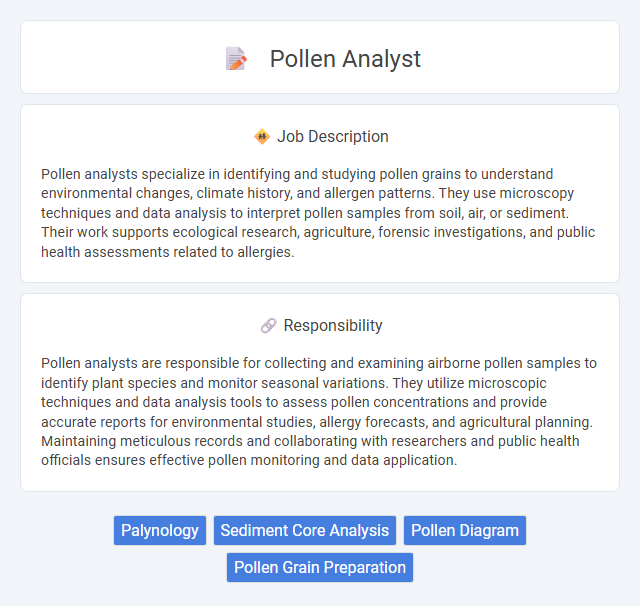
Pollen analysts specialize in identifying and studying pollen grains to understand environmental changes, climate history, and allergen patterns. They use microscopy techniques and data analysis to interpret pollen samples from soil, air, or sediment. Their work supports ecological research, agriculture, forensic investigations, and public health assessments related to allergies.
Individuals with strong attention to detail and a passion for biology or environmental science are likely suitable for a pollen analyst role. Those who are comfortable working in laboratory settings and handling microscopes may find the job fulfilling and manageable. People who struggle with prolonged focus or have allergies to pollen might face challenges in this career path.
Qualification
A Pollen Analyst typically requires a degree in environmental science, biology, or a related field with specialized training in aerobiology or palynology. Strong skills in microscopic identification, data analysis, and knowledge of pollen distribution patterns are essential for accurate air quality and allergy forecasting. Experience with laboratory techniques and pollen monitoring equipment enhances the precision of pollen count reporting and research outcomes.
Responsibility
Pollen analysts are responsible for collecting and examining airborne pollen samples to identify plant species and monitor seasonal variations. They utilize microscopic techniques and data analysis tools to assess pollen concentrations and provide accurate reports for environmental studies, allergy forecasts, and agricultural planning. Maintaining meticulous records and collaborating with researchers and public health officials ensures effective pollen monitoring and data application.
Benefit
A career as a pollen analyst likely offers significant benefits in environmental research and public health by providing critical data on plant species distribution and air quality. It may significantly aid in allergy forecasting and biodiversity monitoring, potentially improving community health outcomes and ecological conservation efforts. Opportunities for specialization and collaboration with ecological and agricultural sectors could enhance professional growth and job stability.
Challenge
A pollen analyst likely faces the challenge of accurately identifying microscopic pollen grains from diverse plant species, requiring extensive knowledge and attention to detail. The variability in pollen preservation and contamination risks might complicate sample analysis, making data interpretation potentially difficult. Precision in reporting and continuous learning about regional flora changes could be critical to maintaining analysis reliability.
Career Advancement
A career as a pollen analyst offers opportunities for advancement through specialization in palynology, environmental consulting, or forensic science. Professionals can progress from entry-level lab technicians to senior analysts, project managers, or academic researchers by gaining expertise in pollen identification, data interpretation, and environmental impact assessments. Continuous education and certifications in botany, ecology, and specialized software increase job prospects and leadership roles within environmental agencies or private research firms.
Key Terms
Palynology
A pollen analyst specializes in palynology, the scientific study of pollen, spores, and other microscopic plant materials to interpret environmental and geological data. This role involves collecting and examining samples from sediment, soil, or air to reconstruct past climates, track vegetation changes, and support archaeological or forensic investigations. Expertise in microscopy, data analysis, and botanical classification is essential for accurate identification and interpretation of pollen assemblages.
Sediment Core Analysis
Pollen analysts specializing in sediment core analysis examine microscopic fossilized pollen grains preserved in sediment layers to reconstruct past vegetation and climate conditions. Using techniques like microscopy and radiocarbon dating, they identify pollen assemblages that reveal environmental changes over thousands of years. Their work supports research in paleoclimatology, archaeology, and ecological restoration by providing accurate historical ecological data.
Pollen Diagram
A Pollen analyst specializes in examining pollen grains and spores to reconstruct past vegetation and climate conditions, utilizing pollen diagrams as a primary tool. Pollen diagrams graphically display the relative abundance of different pollen types over time, aiding in environmental and geological research. This role requires expertise in microscopic analysis, botanical identification, and data interpretation to support paleoecological and archaeological studies.
Pollen Grain Preparation
Pollen analysts specialize in the meticulous preparation of pollen grains, ensuring samples are clean and intact for microscopic examination. Techniques such as acetolysis and staining are employed to enhance the visibility of pollen morphology, critical for accurate identification and classification. Mastery in pollen grain preparation underpins research in palynology, aiding studies in botany, archaeology, and environmental science.
 kuljobs.com
kuljobs.com